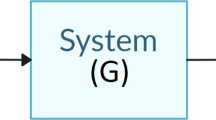Abstract
Up to this time, the only known method to solve the discrete-time mixed sensitivity minimization problem inl 1 has been to use a certain infinite-dimensional linear programming approach, presented by Dahleh and Pearson in 1988 and later modified by Mendlovitz. That approach does not give in general true optimal solutions; only suboptimal ones are obtained. Here, for the first time, the truel 1-optimal solutions are found for some mixed sensitivity minimization problems. In particular, Dahleh and Pearson construct an 11h order suboptimal compensator for a certain second-order plan with first-order weight functions; it is shown that the unique optimal compensator for that problem is rational and of order two. The author discovered this fact when trying out a new scheme of solving the infinite-dimensional linear programming system. This scheme is of independent interest, because when it is combined with the Dahleh-Pearson-Mendlovitz scheme, it gives both an upper bound and a lower bound on the optimal performance; hence, it provides the missing error bound that enables one to truncate the solution. Of course, truncation is appropriate only if the order of the optimal compensator is too high. This may indeed be the case, as is shown with an example where the order of the optimal compensator can be arbitrarily high.
Similar content being viewed by others
References
Francis, B. A.,A Course in H ∞ Control Theory, Springer-Verlag, Berlin, Germany, 1987.
Doyle, J. C., Glover, K., Khargonekar, P. P., andFrancis, B. A.,State-Space Solutions to Standard H 2 and H ∞ 27Control Problems, IEEE Transactions on Automatic Control, Vol. 34, pp. 831–847, 1989.
Vidyasagar, M.,Optimal Rejection of Persistent Disturbances, IEEE Transactions on Automatic Control, Vol. 31, pp. 527–534, 1986.
Dahleh, M. A., andPearson, J. B.,l 1-Optimal-Feedback Controllers for Discrete-Time Systems, Proceedings of the 1986 American Control Conference, Seattle, Washington, pp. 1964–1968, 1986.
Dahleh, M. A., andPearson, J. B.,l 1-Optimal Feedback Controllers for MIMO Discrete-Time Systems, IEEE Transactions on Automatic Control, Vol. 32, pp. 314–322, 1987.
Dahleh, M. A., andPearson, J. B.,L 1-Optimal Feedback Controllers for Continuous-Time Systems, IEEE Transactions on Automatic Control, Vol. 32, pp. 889–895, 1987.
Dahleh, M. A., andPearson, J. B.,Optimal Rejection of Persistent Disturbances, Robust Stability, and Mixed Sensitivity Minimization, IEEE Transactions on Automatic Control, Vol. 33, pp. 722–731, 1988.
Mendlovitz, M. A.,A Simple Solution to the l 1-Optimization Problem, Systems and Control Letters, Vol. 12, pp. 461–463, 1989.
Meyer, D. G.,Two Properties of l 1-Optimal Controllers, IEEE Transactions on Automatic Control, Vol. 33, pp. 876–878, 1988.
Staffans, O. J.,On the Four-Block Model Matching Problem in l 1, Journal of Optimization Theory and Applications (to appear).
Staffans, O. J.,MIMO l 1-Optimization with a Scalar Control (to appear).
Author information
Authors and Affiliations
Additional information
Communicated by J. B. Pearson
Rights and permissions
About this article
Cite this article
Staffans, O.J. Mixed sensitivity minimization problems with rationall 1-optimal solutions. J Optim Theory Appl 70, 173–189 (1991). https://doi.org/10.1007/BF00940510
Issue Date:
DOI: https://doi.org/10.1007/BF00940510




